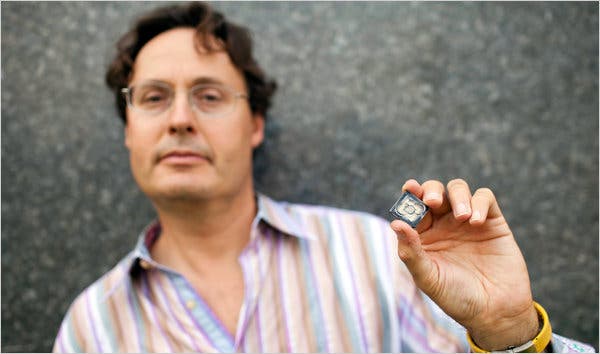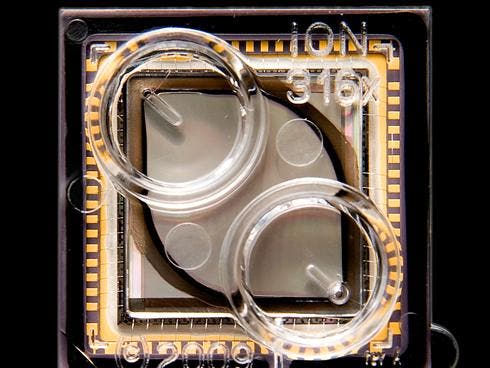
News of a low-cost semiconductor-based gene sequencing machine has been reported this Wednesday in the journal Nature, by a team led by Jonathan Rothberg. The astonishing advancement might lead to a age of personal human genome sequence, where people will be able to decipher their own DNA for as low as $1000.
The human genome was first mapped in 2001 and cost roughly $1 billion to do. Now, ten years and other tens of billions of dollars later important advancements have led to further detailed research, like the sequencing of a complete neanderthal genome, as well as optimization of the process and technology employed so it might become cheaper and faster.
Inventor, Jonathan Rothberg of Ion Torrent Systems in Guilford, Conn., is one of several pursuing the goal of a $1,000 human genome, which he said he could reach by 2013 because his machine is rapidly being improved. To test their genome device, they chose to map the one of Intel’s co-founder, Gordon Moore, the man behind the famed “Moore’s Law” prediction of exponentially growing computer power.
“Gordon Moore worked out all the tricks that gave us modern semiconductors, so he should be the first person to be sequenced on a semiconductor,” Dr. Rothberg said.

The technology employs semiconductor chip to sense DNA or genetic material by detecting a voltage change, instead of light. This eliminates the use of highly expensive equipment that would’ve been required otherwise. Using this tech, the evolution of which is compared by its researchers with that of the digital camera, scientists have been able to scan three bacterial strains and one human genome.
“When it [digital photography] first started out, the resolution was not good and the pictures were not as good as on film. But the technology improved, which made it more accessible and now more people can enjoy photography and become better photographers,” Dr. Maneesh Jain, vice president of marketing and business development at Ion Torrent said.
The human genome is that of Dr. Moore, as you’ve been given to find out earlier, and as for the bacterial strains, the first two genomes of the deadly E. coli bacteria that swept Europe in the spring were decoded on the company’s machines. The whole decoding process takes less than two hours to complete!
Applications, of course, are numerous especially for the common users. At $1000, a genome sequence might become as common as a medical check in the very close future. You’d then be confronted with your very own mapped genome, which when interpreted can describe various medical condition predispositions, leading to the so-called personalized medicine, which seeks to avoid trial-and-error by using genetic data found during a scan to better pair treatments with diseases.
Tell me what your genes are, so I can tell you who you are
Don’t expect everything you get back to be extremely accurate, though. Dr. Moore’s genome has a genetic variant that denotes a “56 percent chance of brown eyes,” one that indicates a “typical amount of freckling” and another that confers “moderately higher odds of smelling asparagus in one’s urine,” Dr. Rothberg and his colleagues reported. Also, Dr. Moore’s genome has two strains that seems to indicated towards an “increased risk of mental retardation” — which was obviously never the case.
Genetic hazards, however, come at a much lower stake than those caught up during one’s lifetime.
“Most of what genetics tell us is that there are a lot of fairly common variants that have a modest degree of risk for diseases,” Dr. Peter Gregersen, director of the Robert S. Boas Center for Genomics and Human Genetics at the Feinstein Institute for Medical Research in Manhasset, N.Y said. “This is important from a scientific point of view, but the data itself is not actionable.
“The risk of disease associated with high blood pressure, smoking and high cholesterol is far greater than most of the genetic risks coming out of whole genome scanning,” Gregersen added. For example, if your genome scan identified a mutation that put you at risk for macular degeneration, a leading cause of blindness, “you may see an ophthalmologist, and there are forms that are treatable, but knowing your genetics won’t impact this much,” he said.
More time, research and money is needed for a more useful information to be outputted by a genome sequencing machine, as the human DNA is decoded to a more precise degree. We might be headed towards Gattaca hell, a utopian/dystopian climate, depends on how you decide to favor it, where everything will be known about you before you’re even born – how you’ll look when you’re 25, how smart can you become, where you’d be best fitted for work, whether there’s a chance you’ll condone in criminal behavior, etc. It’s all in the genes my momma used to tell me…






